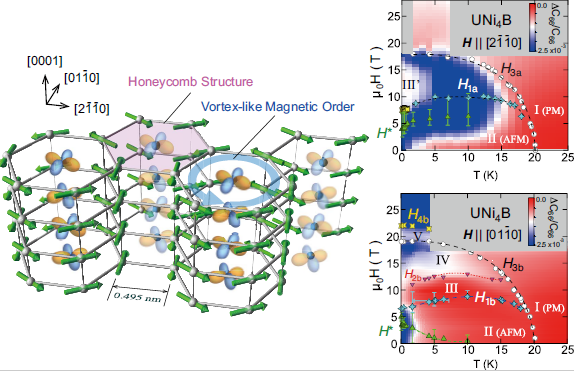Tatsuya Yanagisawa, Hokkaido University and Sergei Zherlitsyn, HLD Dresden.
Researchers from Japan and the Czech Republic, together with scientists from the HLD, have succeeded in identifying that electric quadrupoles play an important role in the magnetic order of the honeycomb-layer compound UNi4B. The scientists showed that these quadrupoles maintain their degrees of freedom without ordering at the center of a magnetic vortex arrangement (left panel in the figure).
In this study, the cooperation partners combined ultrasound technique, which can sensitively detect orbital degrees of freedom, with the advanced high magnetic-field generation equipment at the HLD and the High Field Laboratory for Superconducting Materials at Tohoku University. The researchers performed precise measurements of the electric quadrupoles derived from the orbital degrees of freedom in the vortex magnetic state of UNi4B. They observed strong correlations between the magnetic vortices and electric quadrupoles.
The elastic constants show large variations in magnetic-field regions where the vortex magnetic structure changes. This indicates that the quadrupole response evolves rapidly in magnetic field (right panels in the figure). Here, phase II represents a magnetic-toroidal dipolar order showing a vortex magnetic structure. The response of the quadrupoles depends strongly on the in-plane direction of the applied magnetic field. For H || [01-10], a phase V, which does not exist for H || [2-1-10], appears at high magnetic fields and low temperatures. Further, the contour plot shows a significant difference in the elastic constant C66 for the two field directions, although there is no difference in the magnetization. From the blue and red contrasts in the ordered phases, we can conclude that the electric quadrupoles play an important role in the vortex-like magnetic structure of this system, modifying the spin-reorientation process as well.
These findings advance our understanding of the fundamental phenomena related to the interaction between quadrupolar degrees of freedom and magnetic vortices. This might provide a cornerstone for the realization of completely new quantum-information devices that control electronic degrees of freedom in solids in future applications.

Figure: (Left panel) Crystal structure, magnetic vortices, and electric quadrupoles in UNi4B. Magnetic field-temperature phase diagram with magnetic field applied along [01-10] (right, lower panel) and along [2-1-10] (right, upper panel). The color code indicates the changes in the elastic constant C66.
Electric Quadrupolar Contributions in the Magnetic Phases of UNi4B, T. Yanagisawa, H. Matsumori, H. Saito, H. Hidaka, H. Amitsuka, S. Nakamura, S. Awaji, D. I. Gorbunov, S. Zherlitsyn, J. Wosnitza, K. Uhlířová, M. Vališka, and V. Sechovský, Phys. Rev. Lett. 126, 157201 (2021) https://journals.aps.org/prl/abstract/10.1103/PhysRevLett.126.157201
Contact: tatsuya@cris.hokudai.ac.jp






